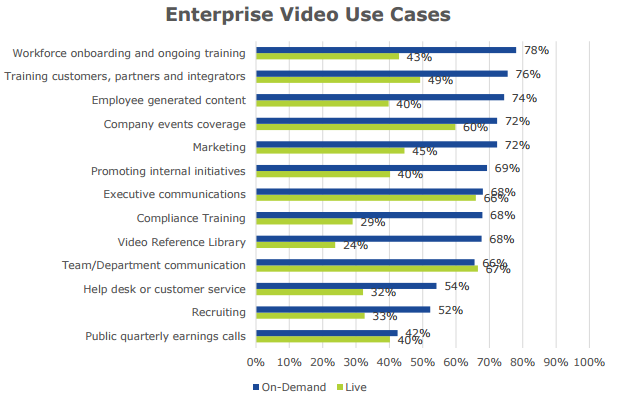How Enterprises Benefit from Video Content
The adoption of video in enterprise organizations is skyrocketing as businesses expand across a global footprint, and video enables their employees to look into the eyes of their clients and their colleagues from the other side of the world. Technavios analysts forecast the global online video platform market to grow at a CAGR of 14.88% from 2016 to 2020. Due to the storage and bandwidth size of the data, management of video content used to be burdensome in the past, but as the technology has evolved, now more and more organizations are embracing video. Gartner defines enterprise video content management as: "Software, appliances or software as a service (SaaS) intended to manage and facilitate the delivery of one-to-any, on-demand video across internet protocols."
a global footprint, and video enables their employees to look into the eyes of their clients and their colleagues from the other side of the world. Technavios analysts forecast the global online video platform market to grow at a CAGR of 14.88% from 2016 to 2020. Due to the storage and bandwidth size of the data, management of video content used to be burdensome in the past, but as the technology has evolved, now more and more organizations are embracing video. Gartner defines enterprise video content management as: "Software, appliances or software as a service (SaaS) intended to manage and facilitate the delivery of one-to-any, on-demand video across internet protocols."
Although the vast majority of the vendors in the market develop video delivery to people who are external to enterprises, the highest demand from organizations is for vendors that perfectly support internal delivery, as the video capabilities can blur the line between the next cubicle and the next continent, when it comes to collaboration and communication. With many employees working from remote locations, video has become essential for communicating effectively and making everyone feel part of the team.
How Enterprises Benefit from Video Content
According to Kaltura’s third annual State of Enterprise Video report, an international study that examines the evolving use of video, by surveying around 500 enterprise professionals, almost three-quarters (73%) of respondents’ organizations produce more than 5 internal webcasts a year, while nearly a third produce a whopping 50 or more. In terms of use cases, the study suggests that the most popular use is the training of various kinds, followed closely by employee-generated content, company events coverage, and marketing. The chart below has been retrieved from Kaltura’s study:

Source: State of Enterprise Video report
The study revealed that over 90% of respondents saw at least some value in the use of video in nearly every one of the listed organizational goals. More than half considered video very valuable for four of the goals: improving communications, training employees better/faster, connecting geographically dispersed employees, and enhancing product marketing and brand awareness.
Here are the significant business outcomes of online video platforms:
-
Work-life balance. Instead of burning their employees out with a myriad amount of business travel per year, with intuitive collaboration technologies, employees can stay on top of what’s happening in the workplace without having to sacrifice work-life balance. According to Aberdeen, the emphasis on organizational openness is 30 percent higher among outperforming organizations.
-
Faster and better employee training. Training a new employee has a long-term impact on productivity and adoption to company culture. Keeping that in mind, a HubSpot research unveiled the breakdown of what people pay the most attention to versus only skimming for information. The breakdown illustrated that 55% of respondents stated that they pay close attention to video content.
-
Reduction in the risk of losing talent. Enabling employees to provide their work-life balance expectedly has a positive impact on their engagement with organizations, too. In fact, the study shows that 81 percent of engaged employees intend to stay with their current employers which leads to 22 percent higher profits for the company.
-
Cost reduction. Cisco believes that video collaboration plays a huge role in helping them meet the challenges of managing their global workforce as more than 40 percent of their employees work outside the United States. Faced with escalating travel costs, as well as lost productivity due to travel, Cisco expanded their use of collaboration tools as an alternative to travel. As a result, the company saves $250 million in travel costs per year by using video. In addition, 2013 Cisco Global Young Executives’ Video Attitudes Survey of 1300 managers indicated that 87 percent believe video has a significant and positive organizational impact.
According to the data pooled on the IBM Cloud Video service from billions of views over the past two years, enterprise viewership outside of the US grew by more than 25 percent from 2015 to 2016, as international businesses increasingly integrate cloud-based video into their strategies.
Considering the market shift toward a complete offering in 2016, Gartner’s analysists Whit Andrews and Adam Preset, who are the authors of the Gartner Magic Quadrant for Enterprise Video Content Management 2016 report, expect other factors, such as combinations of videos with process flows and games to shift the direction of the market in the long run. Another prediction cited in the report was that wearable video can expand from law enforcement to many field occupations like transportation, logistics, service, and sales in the wake of accelerating demand for Internet of Things. When it comes to purchasing decision criteria, usability and an understanding of particular business needs are the primary factors followed by attractive pricing.
Over the Horizon for Enterprise Video Content
-
Video will become mainstream. Just like preparing PowerPoint presentation, employees will generate video content at will.
-
Video will reinvent communication. Due to the increase in broadband speed, all communication flow within and outside the organization will happen through video only.
-
Video eliminates the negative side effects of globalization. A remarkable increase in the use of webcasts live streaming for staff in disparate areas and downloadable video for people to watch on mobile devices will encourage organizations to expand their footprint to the global markets.
-
Video will most likely be the preferred method for training. Easily digestible short video training clips will replace the written admin manuals.
-
Video also increases customer engagement. Although in this article we discussed the use of video within organizations, video also provides a way to reach not only employees but prospects and existing customers. eMarketer, for instance, expects US digital video ad spending will see double-digit growth annually through 2020. Research firm Advertiser Perceptions found that 72% of marketers planned to invest those digital video ad dollars with YouTube in the next 12 months. Since less competition is established for video content than a text article, an SEO-friendly video on YouTube is 52 times more likely to show up in one of the Google search result pages. More importantly, a study by eyeviewdigital.com shows that using video on landing pages can increase conversion by 80%.
My POV
It is no secret that video makes collaboration easier while increasing productivity and reducing the expenses. To get the most out of video content, it is important to choose a solution that is aligned with your business needs as well as fully compatible with your existing digital ecosystem. Due to a significant increase in cloud computing, more and more organizations are shifting to cloud solutions to reduce their complexity and improve scalability. However, like other technologies, there is no one-size-fits-all approach here. The most important point that any organization shouldn’t compromise on is the ability to access from any device, any network, and any location.

Venus Tamturk
Venus is the Media Reporter for CMS-Connected, with one of her tasks to write thorough articles by creating the most up-to-date and engaging content using B2B digital marketing. She enjoys increasing brand equity and conversion through the strategic use of social media channels and integrated media marketing plans.